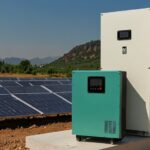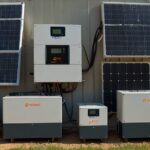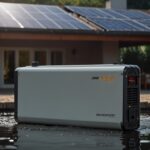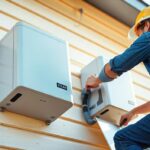Installing a solar panel inverter is a crucial step in setting up a solar power system. The inverter converts DC power from the solar panels into AC power, which can be used to power electrical appliances and devices.
In this blog, we’ll provide a detailed guide on how to install a solar panel inverter, including the necessary tools and materials, safety precautions, and best practices. We’ll also discuss the importance of proper installation and how it can impact the performance and efficiency of the solar power system.
Tools and Materials Needed for Solar Inverter Installation
Before starting the installation process, make sure you have the following tools and materials:
- Solar panel inverter
- Solar panels
- Mounting hardware (e.g., screws, clips, and brackets)
- Electrical wiring and connectors
- DC disconnect switch
- AC disconnect switch
- Grounding equipment (e.g., grounding rods and clamps)
- Safety gear (e.g., gloves, safety glasses, and a hard hat)
- Multimeter
- Wire strippers
- Pliers
- Screwdrivers
- Drill and bits
Safety Precautions While Installing Solar Panel Inverter
Installing a solar panel inverter requires working with electrical systems, which can be hazardous if not done properly. Make sure to follow these safety precautions:
- Turn off the main electrical power supply before starting the installation.
- Wear safety gear, including gloves, safety glasses, and a hard hat.
- Use a ladder or scaffolding to access the roof or installation area, and ensure it is stable and secure.
- Avoid working in wet or humid conditions.
- Use insulated tools and equipment to prevent electrical shock.
- Make sure the area is well-ventilated and free from any obstructions.
Step-by-Step Solar Panel Installation Guide
Here’s a detailed step-by-step guide on how to install a solar panel inverter:
- Mount the Inverter: Mount the inverter to a wall or a mounting bracket, ensuring it is secure and level. Make sure the inverter is installed in a well-ventilated area and away from any obstructions.
- Connect the Solar Panels: Connect the solar panels to the inverter using DC wiring and connectors. Make sure the connections are secure and not loose. Use a multimeter to test the voltage and current of the solar panels.
- Connect the DC Disconnect Switch: Connect the DC disconnect switch to the inverter and solar panels. The DC disconnect switch allows you to disconnect the solar panels from the inverter for maintenance or repair.
- Connect the AC Disconnect Switch: Connect the AC disconnect switch to the inverter and the electrical grid. The AC disconnect switch allows you to disconnect the inverter from the electrical grid for maintenance or repair.
- Ground the System: Ground the system using grounding equipment, such as grounding rods and clamps. This ensures the system is safe and protected from electrical shock.
- Connect the Electrical Wiring: Connect the electrical wiring to the inverter and the electrical grid. Make sure the connections are secure and not loose.
- Test the System: Test the system to ensure it is working properly and efficiently. Use a multimeter to test the voltage and current of the system.
Best Practices to Install a Solar Panel Inverter
Here are some best practices to keep in mind when installing a solar panel inverter:
- Follow the manufacturer’s instructions and guidelines.
- Use high-quality materials and equipment.
- Ensure the installation is secure and level.
- Test the system regularly to ensure it is working properly.
- Keep the installation area clean and free of debris.
- Make sure the inverter is installed in a well-ventilated area and away from any obstructions.
- Use a grounding system to protect the system from electrical shock.
Importance of Proper Installation
Proper installation of a solar panel inverter is crucial for the performance and efficiency of the solar power system. A well-installed inverter can ensure that the system operates at its maximum potential, while a poorly installed inverter can lead to reduced energy production, increased maintenance costs, and safety hazards.
Conclusion
Installing a solar panel inverter requires careful planning, attention to detail, and a focus on safety. By following the steps outlined in this blog, you can ensure a successful installation and a safe and efficient solar power system. Remember to always follow the manufacturer’s instructions and guidelines, and use high-quality materials and equipment.
